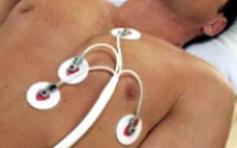- Author: Paul Kaufholz, Philips
- Contact details: paul.kaufholz@philips.com
ECG triggering is one of the use cases considered by project HoliDes in the Health domain. ECG triggering often required during MRI scans to avoid image artefacts due to motion of the heart or blood flow. However, it is not very easy to obtain reliable trigger signals, since both the magnetic field and the scanning techniques distort these signals. A new technique measures the voltages between different leads indicated as V1 and V2 in Figure 1. A smart algorithm based on this cross-referential information can detect the ECG triggers in a different and better way. However, this technique requires some user interaction to get the system properly calibrated.

Figure 1. Pictures of the positioning of the ECG electrodes and an example of an ECG trace
Additional guidance for the operator is required during patient preparation and scanning to improve the reliability of these newly measured ECG triggers.
The UI design on the console for ECG Triggering to guide the user to prepare for manual VCG triggering has been iteratively improved based on user test feedback.
Based on feedback from (1) hospital observations to learn about the current way of working, (2) a user test based on an iterated version of the UI design, a iterated design was created as depicted in Figure 2.
Multiple tools from the Human Factors – Reference Technology Platform (HF-RP) have been used to support this AdCoS, especially tools from Work Package 5 (WP5 - “Empirical Human Factors Analysis Techniques & Tools”) for usability-related activities such as task analysis and user testing. The WP5 tools HF-task analysis from HFC, to analyse user needs, U-DAT from Philips, to capture user test results, in combination with HF-filer from Anywi, to generate a structured report, have been used in different stages.

Figure 2. Final UI design of the main screen for manual ECG Triggering
The formative user test revealed 23 usability issues. All feedback has been taken into account, which has led to the final UI design from Figure 2. The fact that these usability issues were highlighted using the U-DAT based user test has resulted in an improved usability in terms of possible use error and efficiency.
The manual ECG triggering feature has been released as part of the Philips MR scanner software. Feedback from actual customers shows very satisfying results.

